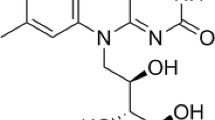Abstract
Riboflavin is an important nutrient for humans and animals. Industrial production has shifted completely from chemical synthesis to microbial fermentation. First generation riboflavin production was improved by a combination of traditional mutagenesis and genetic engineering, and isolated strains have been used in industry. As the DNA genome of riboflavin producers has the potential to reveal new technologies, DNA microarray, proteomic and metabolic analyses have been applied to the analysis of hyper-riboflavin producers. In this review, disparity mutagenesis technology is introduced as a means of improving riboflavin production by Ashbya gossypii. DNA microarray, proteomic and metabolic analyses of this high riboflavin producer are discussed, as well as recent riboflavin production trends, costs and future improvements.


Similar content being viewed by others
References
Abe H, Fujita Y, Chiba Y, Jigami Y, Nakayama K (2009a) Upregulation of genes involved in gluconeogenesis and the glyoxylate cycle suppressed the drug sensitivity of an N-glycosylation-deficient Saccharomyces cerevisiae mutant. Biosci Biotechnol Biochem 73:1398–1403
Abe H, Fujita Y, Takaoka Y, Kurita E, Yanos S, Tanaka N, Nakayama K (2009b) Ethanol-tolerant Saccharomyces cerevisiae strains isolated under selective condition by overexpression of a proofreading-deficient DNA polymerase delta. J Biosci Bioeng 108:199–204
Abe H, Takaoka Y, Chiba Y, Sato N, Ohgiya S, Itadani A, Hirashima M, Shimoda C, Jigami Y, Nakayama K (2009c) Development of valuable yeast strains using a novel mutagenesis technique for the effective production of therapeutic glycoprotein. Glycobiology 19:428–436
Aoki K, Furusawa M (2001) Promotion of evolution by intracellular coexistence of mutator and normal DNA polymerases. J Theor Biol 209:213–222
Demain AL (1972) Riboflavin oversynthesis. Annu Rev Microbiol 26:369–388
Dietrich FS, Voegelli S, Brachat S, Lerch A, Gates K, Steiner S, Mohr C, Pöhlmann R, Luedi P, Choi S, Wing RA, Flavier A, Graffney TD, Philippsen P (2004) The Ashbya gossypii genome as a tool for mapping the ancient Saccharomyces cerevisiae genome. Science 304:304–307
Duan YX, Chen T, Chen X, Zhao XM (2010) Overexpression of glucose-6-phpsphate dehydrogenase enhances riboflavin production in Bacullus subtilis. Appl Microbiol Biotechnol 85:1907–1914
Föster C, Santos M, Ruffert S, Krämer R, Revuelta JL (1999) Physiological consequence of disruption of the VMA1 gene in the riboflavin overproducer Ashbya gossypii. J Biol Chem 274:9442–9448
Furusawa M, Doi H (1992) Promotion of evolution: disparity in the frequency of strand-specific misreading between the lagging and leading DNA strands enhances disproportionate accumulation of mutations. J Theor Biol 157:127–133
Furusawa M, Doi H (1998) Asymmetrical DNA replication promotes evolution: disparity theory of evolution. Genetica 102(103):333–347
Jiménez A, Santos MA, Pompejus M, Revuelta JL (2005) Metabolic engineering of the purine pathway for riboflavin production in Ashbya gossypii. Appl Environ Microbiol 71:5743–5751
Jiménez A, Santos MA, Revuelta JL (2008) Phosphoribosyl pyrophosphate synthase activity affects growth and riboflavin production in Ashbya gossypii. BMC Biotechnol 8:67
Karos M, Vilariño C, Bollschweiler C, Revuelta JL (2004) A genome-wide transcription analysis of a fungal riboflavin overproducer. J Biotechnol 113:69–76
Kato T, Park EY (2006) Expression of alanine: glyoxylate aminotransferase gene from Saccharomyces cerevisiae in Ashbya gossypii. Appl Microbiol Biotechnol 71:46–52
Mateos L, Jiménez A, Revuelta J, Santos M (2006) Purine biosynthesis, riboflavin production, and trophic phase span are controlled by a Myb-related transcription factor in the fungus Ashbya gossypii. Appl Environ Microbiol 72:5052–5060
Ming H, Lara Pizarro AV, Park EY (2003) Application of waste activated bleaching earth containing rapeseed oil on riboflavin production in the culture of Ashbya gossypii. Biotechnol Prog 19:410–417
Monschau N, Sahm H, Stahmann KP (1998) Threonine aldolase overexpression plus threonine supplementation enhanced riboflavin production in Ashbya gossypii. Appl Environ Microbiol 64:4283–4290
Park EY, Zhang JH, Tajima S, Dwiarti L (2007) Isolation of Ashbya gossypii mutant for an improved riboflavin production targeting for biorefinery technology. J Appl Microbiol 103:468–476
Park EY, Ito Y, Nariyama M, Sugimoto T, Lies D, Kato T (2011) The improvement of riboflavin production in Ashbya gossypii via disparity mutagenesis and DNA microarray analysis. Appl Microbiol Biotechnol 91:1315–1326
Plaut GWE (1954) Biosynthesis of riboflavin I. Incorporation of 14C-labelled compounds into rings B and C. J Biol Chem 208:513–520
Schlösser T, Schmidt G, Stahmann KP (2001) Transcriptional regulation of 3,4-dihydroxy-2-butanone 4-phosphate synthase. Microbiology 147:3377–3386
Schlüpen C, Santos MA, Weber U, De Graaf A, Revuelta JL, Stahmann KP (2003) Disruption of the SHM2 gene, encoding one of two serine hydroxymethyltransferase isozymes, reduces the flux from glycine to serine in Ashbya gossypii. Biochem J 369:263–273
Schmidt G, Stahmann KP, Kaesler B, Sahm H (1996a) Correlation of isocitrate lyase activity and riboflavin formation in the riboflavin overproducer Ashbya gossypii. Microbiology 142:419–426
Schmidt G, Stahmann KP, Sahm H (1996b) Inhibition of purified isocitrate lyase identified itaconate and oxalate as potential antimetabolites for the riboflavin overproducer Ashbya gossypii. Microbiology 142:411–417
Shimoda C, Itadani A, Sugino A, Furusawa M (2006) Isolation of thermotolerant mutants by using proofreading-deficient DNA polymerase δ as an effective mutator in Saccharomyces cerevisiae. Genes Genet Syst 81:391–397
Stahmann KP, Revuelta JL, Seulberger H (2000) Three biotechnical processes using Ashbya gossypii, Candida famata, or Bacillus subtilis compete with chemical riboflavin production. Appl Microbiol Biotechnol 53:509–516
Sugimoto T, Morimoto A, Nariyama M, Kato T, Park EY (2010) Isolation of an oxalate-resistant Ashbya gossypii strain and its improved riboflavin production. J Ind Microbiol Biotechnol 37:57–64
Author information
Authors and Affiliations
Corresponding author
Rights and permissions
About this article
Cite this article
Kato, T., Park, E.Y. Riboflavin production by Ashbya gossypii . Biotechnol Lett 34, 611–618 (2012). https://doi.org/10.1007/s10529-011-0833-z
Received:
Accepted:
Published:
Issue Date:
DOI: https://doi.org/10.1007/s10529-011-0833-z




